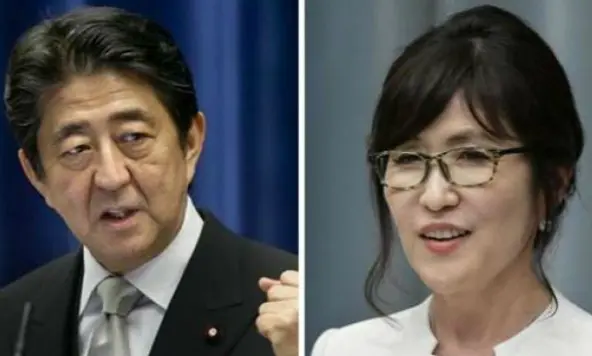Prime Minister Shinzo Abe reshuffled his Cabinet on Wednesday, appointing a new defence minister with a history of hawkish views, in the third reshuffle since he returned as premier in December 2012.
In a renewed bid to drive his “Abenomics” economic policy package forward, Abe has kept eight of the previous Cabinet’s 19 members in their current roles, including his right-hand man Chief Cabinet Secretary Yoshihide Suga and Finance Minister Taro Aso.
“By lining up policy experts from our party and heavy-hitting economic ministers, I will give our growth strategy a burst of acceleration,” Abe told a press conference after the shake-up.
Tomomi Inada, policy chief in Abe’s Liberal Democratic Party, has replaced Gen Nakatani as defence minister. She is known for her rapport with Abe on security and foreign policy and has been outspoken on polarising historical issues involving Asian neighbours.
Foreign Minister Fumio Kishida, Economic and Fiscal Policy Minister Nobuteru Ishihara, Internal Affairs and Communications Minister Sanae Takaichi and Health, Labour and Welfare Minister Yasuhisa Shiozaki have kept their jobs, as has Land, Infrastructure, Transport and Tourism Minister Keiichi Ishii.
Inada’s appointment as defence minister comes as the administration is closer than ever before to amending Japan’s pacifist Constitution for the first time since its enactment following the second world war, a long-standing ambition the new defence chief shares with Abe.
Gains by the LDP, Komeito and like-minded lawmakers in the July upper house election have given pro-reformers the two-thirds majority in the Diet legally required to propose amendments, which must then gain a majority in a national referendum.
Abe said constitutional reform is “the LDP’s party line, so it’s only natural for me to want to realise it during my term as party president”.
The premier stressed that the LDP’s draft amendment will undergo thorough review by cross-party constitutional reform commissions in each house of the Diet.
In January, Inada urged reform of the second line of Article 9, which bans Japan from possessing armed forces or other war potential, calling it “the most hollowed out” part of the Constitution.
Last year she called for the establishment of a panel within the LDP to re-examine the Tokyo trials that convicted several Japanese leaders as war criminals over atrocities in the second world war.
Inada has regularly visited Yasukuni Shrine, a Shinto shrine in Tokyo seen by China and South Korea as a symbol of Japan’s past militarism, including on last year’s anniversary of the war’s end.
Asked after her appointment on Wednesday if she will do so again this August15, the 71st anniversary of Japan’s surrender, Inada told a press conference the Yasukuni issue is “a matter of the heart”, and “I shouldn’t say whether or not I should go.”
“I would like to make an appropriate decision as a member of the Abe Cabinet,” she added.
Opposition parties immediately criticised the line-up, with a Democratic Party executive calling it “nothing refreshing” as many former Cabinet members remained either in the same job or given another Cabinet post.
Others raised concerns about the effect of Inada’s appointment on the debate over amending the Constitution. Most of the opposition parties are against constitutional reform.
Despite Abe’s touting of achievements under Abenomics, Japan’s economy has lacked the strength to pull out of deflation and now faces concerns over a slowdown in China and other emerging economies and worry over from Britain’s decision to leave the European Union.
Addressing a press conference after his appointment, Seko pledged to “reinforce the framework of innovation, encourage aggressive investment, foster venture [enterprise], create jobs in the regions, and strive to assist the small and midsize firms that support regional economies.”
Katsunobu Kato, continuing as minister in charge of implementing Abe’s policies to deal with Japan’s declining birthrate and graying society, will double as minister in charge of reform of working practices, a newly created post.
A new panel under Kato will be tasked with submitting specific plans to improve working practices before the end of the current fiscal year next March, Abe said.
Tamayo Marukawa has been moved from environment minister to minister in charge of the 2020 Tokyo Olympics and Paralympics. Replacing her as environment minister is Koichi Yamamoto, former senior vice minister of internal affairs.
Abe has replaced Justice Minister Mitsuhide Iwaki with LDP lawmaker Katsutoshi Kaneda after Iwaki failed to hold on to his constituency in the upper house election, while LDP lawmaker Yosuke Tsuruho has been made state minister for Okinawa and the Northern Territories to replace Aiko Shimajiri, who also lost her seat.
Kozo Yamamoto, a key architect of Abenomics, has replaced Shigeru Ishiba as minister for regional revitalization after Ishiba said he wants to work outside of the Cabinet.
Abe also shook up the LDP executive lineup Wednesday in his capacity as party president, appointing Toshihiro Nikai, chairman of the ruling party’s General Council, to replace Sadakazu Tanigaki as party secretary general.
(SOUTH CHINA MORNING POST)
 简体中文
简体中文

